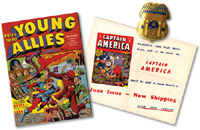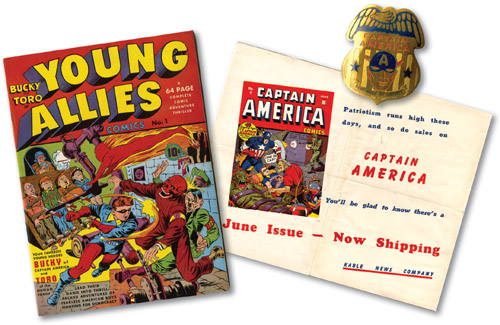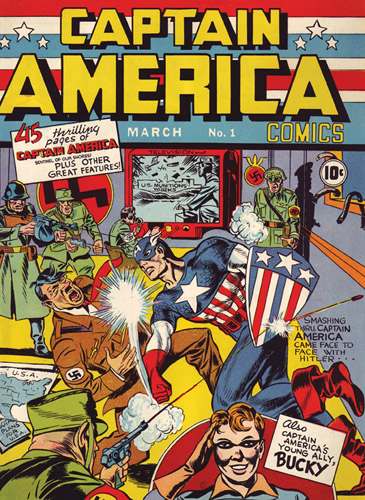By Arnold T. Blumberg
When skinny Steve Rogers submitted himself for a top-secret US government experiment to create a Super Soldier, he had no idea he would become the Sentinel of Liberty and the embodiment of America’s greatest hopes and ideals. But with the downing of a powerful serum, Rogers was transformed into Captain America. The superhero soon known familiarly as Cap was just what WWII Americans needed.


Captain America’s sidekick, Bucky, battled Red Skull in a spinoff in 1941 (left). Heralds (center) told dealers of new Captain America issues. Kids were waiting, wearing their Sentinels of Liberty badges (right). (Geppi’s Entertainment Museum)

Hitler-socking Captain America debuted in March 1941. (Geppi’s Entertainment Museum)Created by Joe Simon and Jack Kirby in the crucible of World War II, the patriotic hero without peer first wowed kids in 1941’s Captain America Comics No. 1 from Timely Comics (which would one day become Marvel Comics). Cap quickly established himself—along with his sidekick, Bucky—as a tireless crusader in the war against the Axis powers. Fighting the Red Skull and countless other Nazi minions, Cap blazed a Stars and Stripes trail around the world before the war’s end slowed his super pace. He fell into temporary obscurity in the 1950s before being revived from a block of ice in the early 1960s, a man of the 1940s living in strange new times. Joining the super team the Avengers, he became the moral center of the modern Marvel Comics universe of heroes.
Perhaps the most important characteristic of Captain America was that he always strove to represent the aspirations that united America. When the law or the current presidential administration clashed with what he believed America should be, he often defied the government, shed his mantle, or went underground. He was invariably proven right.
In 2007 Rogers was assassinated, and his former sidekick, Bucky, took his place as Captain America. As has happened with so many fallen comic book heroes, the original Cap will inevitably return one day to resume his place as a quintessential heroic icon in American pop culture.


FOLLOW US »
